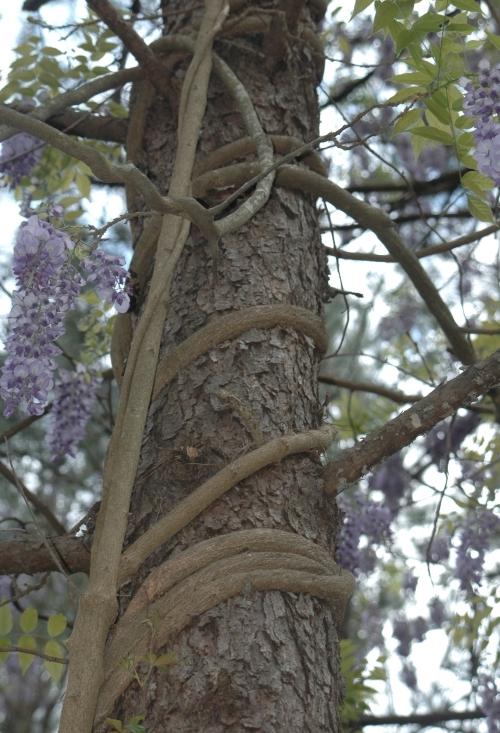About Chinese and Japanese Wisteria
Life cycle and background
Asian wisteria (Wisteria sinensis, Wisteria floribunda, and floribunda x sinensis hybrids) are perennial woody vines that have been planted extensively for their ornamental flowers. When they escape gardens and establish in natural areas, exotic wisterias displace native vegetation. They kill mature trees by shading and strangling them with thick, heavy vines.
The Maryland Department of Agriculture has classified these plants as Tier 2 Invasive. This means that retailers must post a conspicuous sign indicating the plants’ invasiveness, and a person may not provide landscaping services to plant or supply for planting a Tier 2 invasive plant unless the person provides to customers a list of Tier 2 invasive plants.
Invasive Plants to Avoid Buying for your Yard and Garden in Maryland
Growth habit
Fast growing, deciduous woody vines with showy, fragrant lavender-purple flowers in dangling clusters 6-20 inches long. Flowers in April-May before leaves emerge. (Native American wisteria blooms in the summer.) Vines of Chinese wisteria grow in a counter-clockwise direction (as do those of our native wisteria). Japanese wisteria vines grow clockwise. Leaves are compound, about 1 foot long, with 7-13 leaflets on Chinese wisteria and 13-19 on the Japanese variety. Leaves are alternate along the stem. Produces velvety brown seed pods, 4-6 inches long. The native wisteria does not have fuzzy pods.
Reproduction
Spreads by seeds and stems touching the ground. Any piece of root left in the ground can sprout.

Conditions that favor growth
Exotic wisterias prefer full sun but also tolerate shade. They grow in a variety of soil conditions but prefer moist soils. They invade forest edges, roadsides, and ditches.
What to plant instead
American wisteria (Wisteria frutescens), trumpet honeysuckle (Lonicera sempervirens)
Controlling invasive Wisterias
- (PDF) Weeds Gone Wild: Alien Plant Invaders of Natural Areas
- (PDF) Plant Invaders of Mid-Atlantic Natural Areas
- Invasive Vine Control
- (PDF) Control of Invasive Non-Native Plants
Additional resources
Kaufman, Sylvan Ramsey & Wallace Kaufman. 2007. Invasive Plants: Guide to Identification and the Impacts and Control of Common North American Species.
Maryland Invasive Plants Prevention and Control. Maryland Department of Agriculture.
Swearingen J., K. Reshetiloff, B. Slattery, and S. Zwicker. 2002. Plant Invaders of Mid-Atlantic Natural Areas. National Park Service and U.S. Fish & Wildlife Service, Washington, DC.
Compiled by Christa Carignan, reviewed by Debra Ricigliano, University of Maryland Extension, 5/2018
Still have a question? Contact us at Ask Extension.
